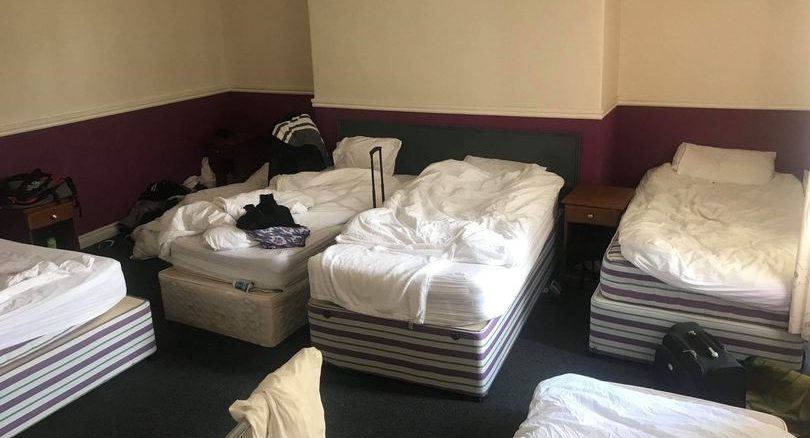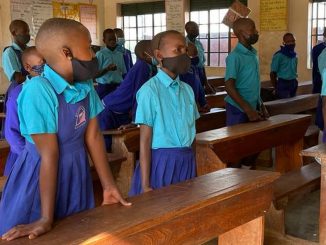
Residents and staff of Direct Provision centres were almost 40% more likely to contract Covid-19 than the general population, according to Covid-19 case numbers from the Health Protection Surveillance Centre (HPSC).
942 cases of Covid-19 were recorded among residents and staff in Direct Provision centres until the end of October 2021.
Figures obtained from the HPSC, a specialist agency within the HSE for monitoring the spread of disease, revealed that for every 100 Direct Provision residents, there were 12.23 cases. This compared with 8.9 cases for every 100 people in the wider community, a discrepancy of 37%.
The agency believes that the figures are “likely under-estimated, especially in wave one (March 1st to August 1st 2020) when these data were not routinely collected.”
Ireland’s Direct Provision centres can currently maintain a capacity of 7,200 people. The majority of centres are not full, according to the International Protection Accommodation Service’s October 2021 report.
Meath was the only county in which the amount of people in Direct Provision exceeded the capacity.
Nick Henderson, CEO of the Irish Refugee Council, stated that his organisation had expected this discrepancy.
“It wasn’t a surprise to us, but it’s concerning the significant number of people who are not family members that are sharing bedrooms,” he told the College View.
In April of this year, the Irish Refugee Council revealed that there had been an increase in the number of unrelated single people in shared bedrooms since the beginning of the pandemic.
“This is reflective of the wider problems of the system; there is poor quality of accommodation, a main feature of which is shared living spaces. It goes against what the message was for everyone else in terms of social distancing,” Henderson added.
The figures were released in response to a parliamentary question made by Independent TD Catherine Connolly, which stated that in April 2020 1,700 people shared a bedroom, which rose to 1,892 people by April 2021.
A report by the Irish Refugee Council surveyed over 400 Direct Provision residents on safety measures within the centres. Over 20% claimed that they did not have access to hand sanitiser, while 50% of respondents said they were unable to socially distance and 55% of respondents said they did not feel safe.
One respondent said: “This place is packed and people are coming in everyday. I feel like our well being is not important to them. We share the same canteen, a lot of people share bathrooms and toilets. The truth of the matter is that we are at risk of dying more than anyone else.”
Lucky Khambule is a former asylum seeker and the co-founder of the Movement of Asylum Seekers in Ireland, an anti-Direct Provision and anti-deportation group formed in 2014.
He believes that there are more cases among residents than staff and that the numbers are skewed.
“Statistics from Direct Provision are often distorted. The staff do not live or sleep in Direct Provision. They show up to work, stay in offices for a lot of the day, and then they get to go home. Residents have no choice but to stay,” he told the College View.
“MASI have been criticising the overcrowding since before the start of the pandemic. Direct provision is not conducive to stopping the spread of the virus. People’s lives were put at risk because of how many people share rooms.”
“I personally know more than twenty people who have gotten the virus,” he added.
One government solution to curb the spread of Covid-19 in Direct Provision centres has been to relocate residents to other forms of accommodation to decrease the crowding in some centres.
More than 100 asylum seekers were transferred to the Skellig Star Hotel in Cahersiveen, Co. Kerry in the early weeks of the pandemic before 25 of them tested positive for the virus.
Residents later went on hunger strike to protest against the conditions in the hotel which led to People Before Profit TD Brid Smith saying that the residents would be “better in a refugee camp in Lebanon.”
Henderson said that: “We [the Irish Refugee Council] called for a reduction in overcrowding but it has to be done the right way and Cahersiveen is an example of the wrong way to do it. People were moved at short notice and put into a hotel that couldn’t really provide social distancing and the staff were not experienced with mitigating Covid-19 risk.”
Testing was rolled out for Direct Provision staff and residents last September due to what were described as “additional challenges” linked to the congregated settings, according to a joint report by the Department of Justice and the HSE.
A report from the HSE to NPHET which evaluated how testing was rolled out in the first two weeks noted that some centres sent letters “declining to be tested.”
Last October, a report from the Ombudsman for Children’s Office found that cases were three times more prevalent among Direct Provision residents than in the general population.
This seems to indicate that coronavirus was highly transmissible in Direct Provision in the initial months of the pandemic, before slowly becoming more aligned with the wider population.
The report titled ‘Life in Lockdown: Children’s views and experiences of living in Direct Provision during the Covid-19 pandemic’ concluded that “the lockdown amplified the isolation, exclusion and marginalisation of these children who were already living, in many cases, on the fringes of Irish society.”
It also stated that, “The living circumstances of those in direct provision accommodation will undoubtedly continue to contribute to Covid-19 cases among this population. Children are aware of this and live with increased anxiety for their own and their family’s safety.”
One child told staff of the Ombudsman’s Office that the centre is “kind of a small place, and once a few people get infected it is so easy for everyone.”
In September, Direct Provision residents were contracting the virus 49% more regularly than members of the general population.
The major increase in cases in October and November has largely reversed this trend.
Jamie Mc Carron
Image Credit: MASI



